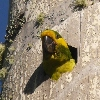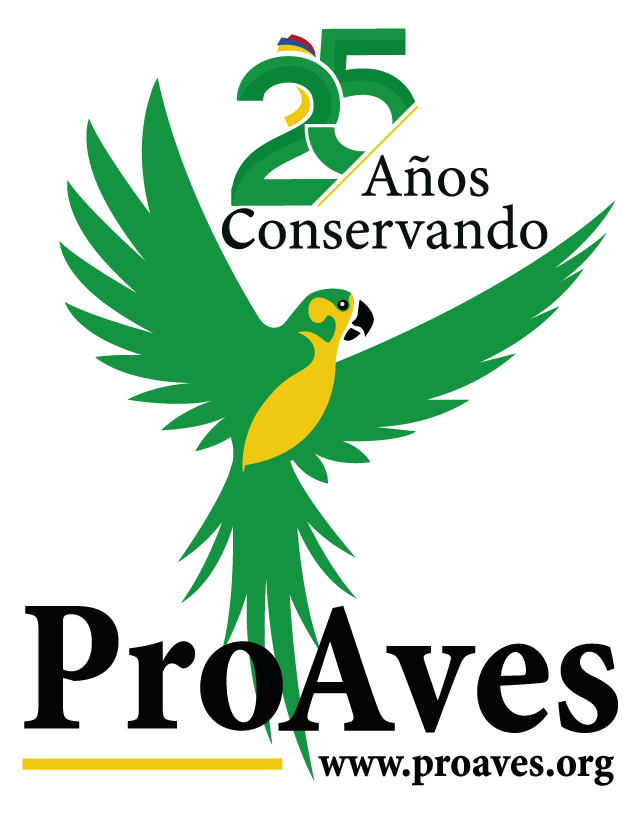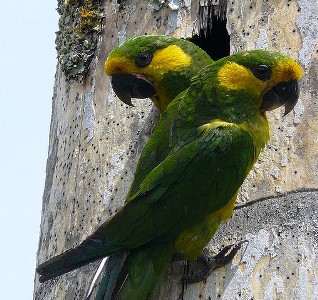|
In 1998 the ProAves Foundation began the Yellow-eared Parrot Project with the support of Loro Parque Fundación, the Society for the Preservation of the Species and Colonies (ZGAP) and American Bird Conservancy. The main aim of this project was the preservation and survival of the species as well as the protection of its habitat in the Colombian Andes. In 1999, after one year of research, it was found a colony of 81 individuals in the Central Andean Mountain Range, in the department of Tolima. Later, in January 2001, a colony of 63 individuals was found in the surroundings of the Western Mountain Range, in the department of Antioquia.
If you would like to know the results concerning the studies and research carried out by ProAves on the topics of the Yellow-eared Parrot’s reproductive biology, ecology and their use of the habitat please consult the following links that resume the conclusions of the study: Reproductive Biology Pacheco Garzón, J.A. 2004. Basic Aspects of the Reproductive Biology in the Yellow-eared Parrot (Ognorhynchus icterotis) in the Roncesvalles-Tolima Municipality. Read Resume Ecology Arango Arbeláez, J.D. B.C, Brock. 2004. Study of the Auto-ecology in an Yellow-eared Parrot Colony (Ognorhynchus icterotis) in Tolima Aiming at the Preservation of This Species. Read Resume Flores, P. 2005. Ecology of a Colony of Yellow-eared Parrots (Ognorhynchus icterotis) in Antioquia and Caldas and its Application to the Preservation of this Species. Read Resume Use of the Habitat Urrego Marín, D.M. 2007. Habitat use of the Yellow-eared Parrot (Ognorhynchus icterotis) in the Municipalities of Jardín (Antioquia) and Riosucio (Caldas). Read Resume
|
Related news
 |
Huge increase in the Yellow-eared Parrot population
Monday 4 October 2010.
The Endangered Yellow-eared Parrot population in Tolima Department has reached historically high population levels with 727 individuals following there most successful breeding season with 291 chicks fledged from 131 nests, thanks to on-going conservation actions.
 |
Environmental Victory for Colombia
Wednesday 26 May 2010.
In 1998, the Yellow-eared Parrot was almost extinct. After 11 years of sustained conservation efforts by ProAves, Loro Parque, CI and ABC the Yellow-eared Parrot has recovered to over 1000 individuals – a triumphant success. Now the IUCN Red List status of the Yellow-eared Parrot is being moved to a less threatened status.
 |
Huge boost for Yellow-eared Parrot population
Wednesday 10 September 2008.
An unprecedented 203 Yellow-eared Parrot chicks successfully fledged from natural nests and artificial nest boxes between May-July 2008. This is the highest fledgling success ever recorded by the ProAves project since commencing in June 1998.
 |
Oustanding breeding succes for Yellow-eared Parrot
Wednesday 5 December 2007.
Supported by Loro Parque Fundación, the best ever breeding season of the Yellow-eared Parrot was recorded in Tolima in 2007: 52 active nests produced 132 chicks!
Great success for the Yellow-eared Parrot
Wednesday 6 December 2006.
The population of the Yellow-eared Parrot has increased greatly since ProAves began to conserve this species in 1998.


 These two colonies have been monitored since then and several studies have been carried out. This has allowed ProAves to get very relevant information regarding their diet, distribution, reproductive biology, use of their habitat and demography among others and all this data has been compiled in a database to use it a the basis for the programming phase of a future strategic action aimed at the preservation of these species.
These two colonies have been monitored since then and several studies have been carried out. This has allowed ProAves to get very relevant information regarding their diet, distribution, reproductive biology, use of their habitat and demography among others and all this data has been compiled in a database to use it a the basis for the programming phase of a future strategic action aimed at the preservation of these species.